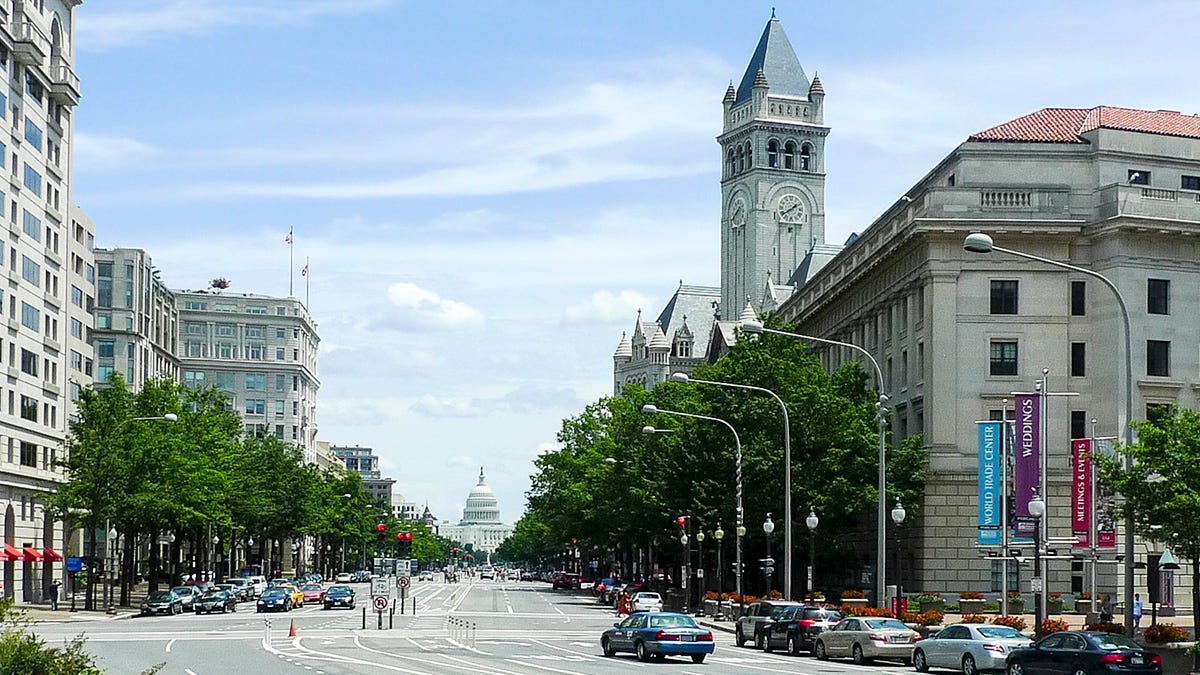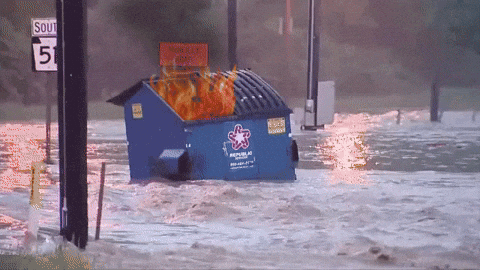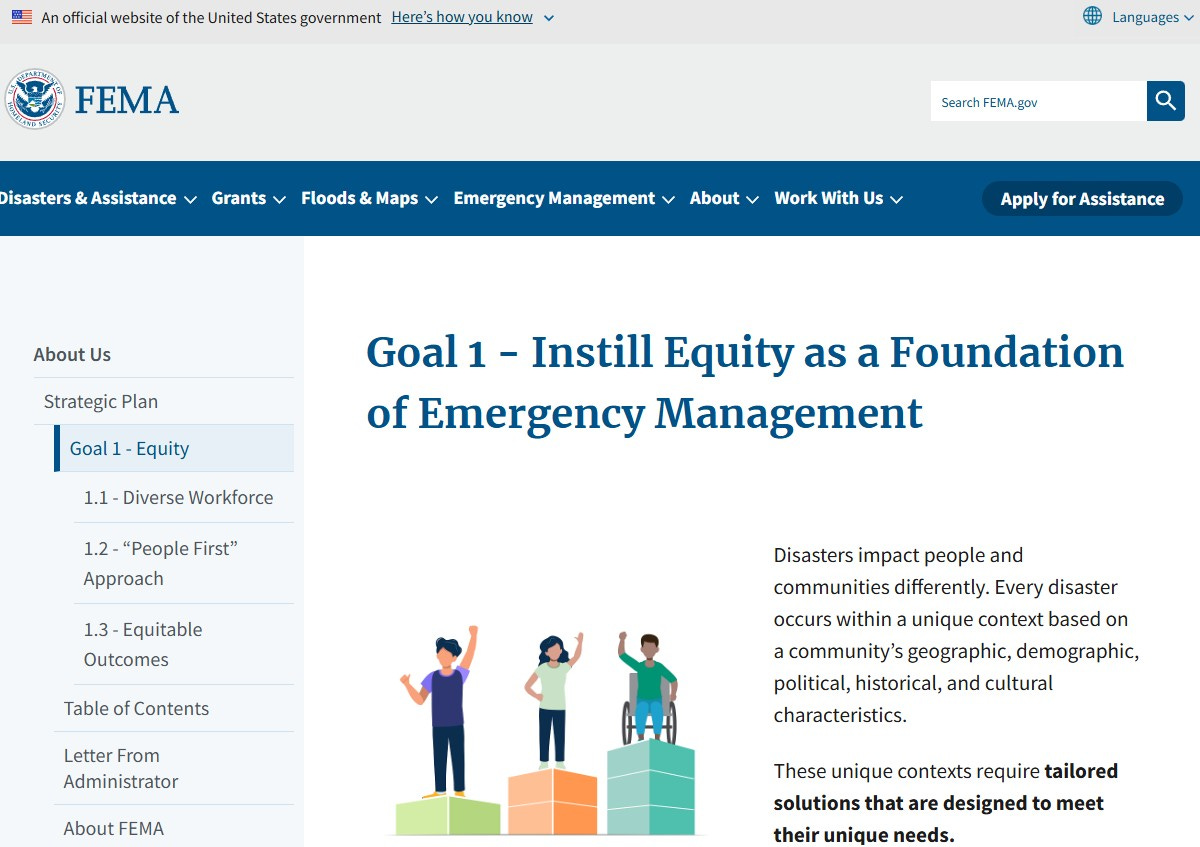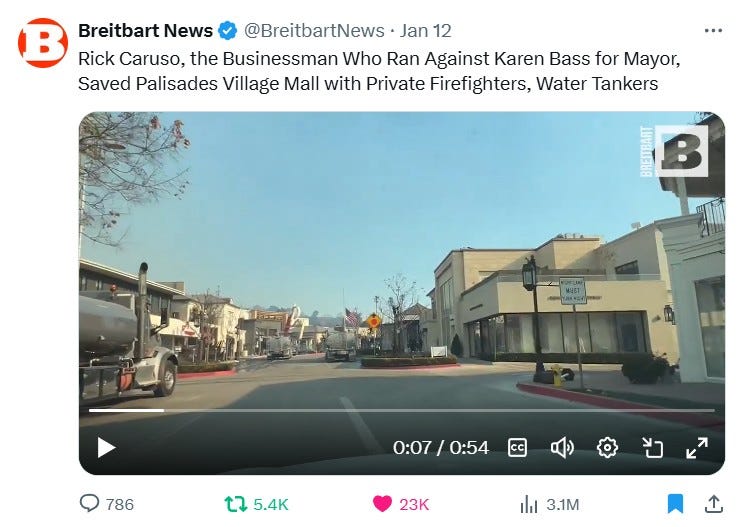Attaching Strings to California Fire Disaster Aid
Do you trust California and Los Angeles to spend federal aid dollars wisely? Me neither. The 1972 Pennsylvania Avenue Development Corporation may be the template.
I hope you had a commemorative Martin Luther King Day and joyous Inauguration Day.
When Vice President JD Vance recently and accurately noted on one of those Sunday morning TV shows few watch that he and President Donald Trump were inheriting a “dumpster fire” from the outgoing Biden-Harris Administration, he was only partially correct.
He should have said, “dumpster fires,” plural, starting with the recovery and rebuilding from the most significant wildfire tragedy in California’s history.
As they were driven from the Capitol to Capitol One Arena and later to the White House, they should have been inspired by what they saw along America’s Main Street, Pennsylvania Avenue, NW.
I’ve already shared several excellent tomes by authors from California about the situation in the Golden State with outstanding insights and analyses I cannot provide. Michael Shellenberger has done the best job of detailing the failures, which are too numerous to list here, but include the fact that over half of LA County fires are set by homeless people. California is home to 25 percent of the nation’s homeless. My friend John Heubusch, former Ronald Reagan Foundation executive director in Simi Valley who was evacuated from his home in California, has written insightfully and has personal experiences with past wildfires in the Los Angeles area.
Ignorable are the idiocies assertions suggesting “climate change” was primarily responsible when simple internet searches can outline dozens of occasions when devastating fires hit this tinderbox and many more, especially in 1938 and 1961. Not helping matters was decades of population and development growth during much of the 20th century (that’s changing now, with California on track to lose up to four US House seats after the 2030 census. They lost one seat for the first time after the 2020 census).
From one of Shellenberger’s recent posts:
The problem is that the LA Fire Department is one of the most severely understaffed of America’s 10 largest cities. It has less than a single firefighter per 1,000 residents compared to Chicago, Dallas, and Houston, which have twice as many.
“ In 1960, our city population was 2.5 million, and we had 112 fire stations. In 2020, our city population was 3.9 million, and we had 106 stations,” a representative of LA’s firefighters ’ union testified last month. “That's 1.4 million more people and six fewer fire stations.”
While fires are endemic and historic to the California coast, growing evidence suggests much of the damage was preventable. From a nearby empty reservoir to failed land management (brush and debris clearing) practices by both federal and state agencies, to the allocation (or not) of resources, from repositioning fire crews to putting money into firefighting instead of diversity programs, it is painfully evident that the level of damage and disaster exceeds what reasonably could have been prevented.
Again, we’re learning in real time that California and much of the nation are suffering from a crisis of government incompetence. Some two dozen people are dead, and at least 5,000 buildings, mostly homes, are destroyed. Now, let’s compare that to the good people of western North Carolina and adjacent parts of Tennessee, West Virginia, and Virginia.
Having said all that, American taxpayers will have to step in and help rebuild or restore much of what California has lost in this tragedy. And this isn’t the only tragedy we’re having to address. Remember Hurricane Helene and the enormous damage to western North Carolina and other parts of Appalachia? Its damage was far more widespread and involved more people, yet it has fallen by the wayside of the media’s attention.
Maybe Harry and Meghan could bring their “disaster tourism” tour to western North Carolina. The Tarheel State could use the attention, although it seems much of the recovery, thanks to strong private and bipartisan state leadership, is getting nearly everyone the help and support they need. The federal response was slow - the 82nd Airborne is located in nearby Fort Liberty (nee Bragg), with its ample earth-moving equipment, and it took several days, if not weeks, to mobilize. The Federal Emergency Management Administration’s response was also not without controversy, from recently trying to eject 1,200 victims from hotels on 24-hour notice (that was resolved) to bypassing homes with Trump for President signs during the initial response. It will take years for the region to rebuild, and some enterprises are permanently closed.
However, North Carolina and most of the country have an advantage over California: competent governance and, in nearly every case, lower taxes—much lower taxes.
To be clear, California’s crisis of incompetence isn’t limited to its state, county, or local governments (and not all, even then). The Federal government owns considerable real estate in the hills around the Los Angeles basin, and federal land management practices haven’t been much better than California’s over the past several years. Maybe federal agencies should reconsider their priorities.
I suspect this will change very soon. Maybe they should consider worrying less about whose “stolen lands” they’re working on (Mexico would like a word) and focus on, you know, the job.
California is drenched in an alphabet soup of never-ending state and local regulators, from the California Coastal Commission to the California Department of Forestry and Fire Protection. The Federal government is no better. At least five agencies within two Cabinet departments have jurisdiction over federal lands, from the Bureau of Land Management to the Fish and Wildlife Service. A “master cooperative wildland fire management agreement” exists between the state and several federal agencies. Still, it reads like a word salad of who pays for or is responsible for this or that, and it didn’t seem to help mitigate the recent fires in and around Los Angeles.
And the word “accountability” only appears once in the 110-page “agreement.”
Cutting through all this will be the challenge of the recovery and rebuild. The question is, how should it happen?
Growing up in Oklahoma (tornadoes) and having played a tiny part in the “Superstorm Sandy” disaster recovery along New Jersey’s coast just before the 2012 election, I know that the response to these things go between pre-planned, with first responders, insurance companies, and especially state and federal agencies experienced with such disasters, to ad hoc, “all hands on deck” when the unexpected (see: Tropical Storm Helene) Still, there’s no doubt who ultimately is in charge, if only to coordinate everything - the governor.

That was certainly the case in Superstorm Sandy 12 years ago. Governor Chris Christie and his administration took complete control and responsibility, coordinating with the Obama Administration and local first responders. Industry trade associations identified as “critical infrastructure” were mobilized, and I was part of the New Jersey Food Council’s team. For Christie and his team, facing their own reelection campaign the following year, all politics was shoved aside as he made it about New Jersey First. Obama got every photo op he wanted from the glad-handing keynote speaker at Mitt Romney’s presidential nominating convention. Christie reportedly sat atop Romney’s vice presidential running mate list until he opted for House Speaker Paul Ryan.
A few days after the storm, I was contacted by a friend with Spectra Energy, a Canadian gas company. “We’ve got twelve crews and trucks ready to go to New Jersey, but because the US doesn’t recognize Canadian gas certifications, they’re not being allowed in,” I was told. I’d been the former chair of the Canadian American Business Council and was a point of contact for business folks in Canada who wanted to help. I immediately contacted my friend, Secretary of Transportation Ray LaHood, a former GOP congressman. The Deputy Secretary called back immediately and told me a waiver would be granted momentarily. The crew was on its way to shut off damaged gas lines, working alongside other gas workers, within 12 hours.
It’s common, even necessary, to waive or circumvent red tape and regulations at times like these. Even California Gov. Gavin Newsom has done that to a limited degree by decreeing regulatory waivers to provide temporary housing. He also signed another executive order to stop what he termed “predatory” real estate investors making below-market offers, which might be an unconstitutional “taking” of someone’s property. Otherwise, he’s pointing fingers at Mayor Karen Bass and local officials for things like dry reservoirs and fire hydrants.
Some victims and members of the Mitt Romney presidential campaign may quibble, but by any measure, Christie’s management of the initial Sandy response was textbook and stellar. I wasn’t involved in the rebuild, so I’ll let others weigh in.
Given the demonstrable incompetence from local and state California officials, what’s the right approach to the inevitable federal aid that has already been promised for recovery if not rebuilding?
The options include following the norm and allowing the Governor and state officials to take the money and work with federal agencies on how it is spent, perhaps with a federal “coordinator,” to expedite matters (there’s precedent for the Secretary of Transportation to play a role, as Secretary Sam Skinner did following the Loma Prieta earthquake near Los Gatos, California, in 1989), but that was before the Department of Homeland Security was created (1992). That’s also what the Federal Emergency Management Administration (FEMA) is for — at least then, they’re not making diversity, equity, and inclusion Job One.
A second option is for the Trump Administration and Congress to impose conditions through legislation. Some might consider this a violation of “legislating on appropriation bills,” a no-no, but that’s incorrect; conditions on appropriations are mainly within the scope of such legislation. But that’s a challenge on two fronts, if not more. The negotiations and bickering would also delay things and mess up plans to implement much of the Trump agenda through forthcoming budget and reconciliation bills (although they could try to include aid and conditions through that mechanism, which would allow it to escape Senate filibuster rules).
Congressional delegations in weather-disaster-prone states—think the Gulf and lower Atlantic coast states like Florida, Louisiana, and Texas, and, of course, earthquake—and fire-prone California—will be worried about the precedent being set, including a future Ocasio-Cortez Administration (shudder), with a Democratic Congress imposing all matters of green energy, DEI, and abortion access conditions in a future disaster aid. That’s no small matter.
But there’s a third option - a “special purpose” corporation, not to be confused with a “social purpose corporation.” And there’s precedent in our nation’s capitol city.
President Richard Nixon signed the Pennsylvania Avenue Development Corporation Act into law in 1972 with the upcoming bicentennial of our nation's independence in just four years. After years of blight along “America’s Main Street,” connecting the White House to the US Capitol—first noted by President John F. Kennedy during his inauguration—and two failed advisory committees, a Democratic Congress and a Republican President combined to create a corporation with the power to redevelop the blighted area. Then, White House aide for Urban Affairs and future US Senator Daniel Patrick Moynihan was the impetus behind it, along with former First Lady Jackie Kennedy.

“. . . the powers conferred by this chapter are for public uses and purposes for which public powers may be employed, public funds may be expended, and the power of eminent domain and the police power may be exercised, and the granting of such powers is necessary for the public interest,” the law proscribed. The Corporation lasted about 20 years; a new initiative replaced it 10 years ago.
The area, once known as “Murder Bay” due to its high crime rate and prostitution, began its odyssey into what you see today: a thriving commercial and government enterprise that includes the Embassy of Canada, a Navy Memorial, and a few blocks away, the Capitol One Arena. The plans can be found here. The PADC ultimately invested $1.5 billion to successfully rebuild and revive Pennsylvania Avenue and nearby environs.
I arrived in Washington as a young congressional staffer in late 1978. I recall the blight of downtown DC, including the horrific conditions at Union Station, which operated as a significant yet largely boarded-up rail hub but lacked any retail establishments. No initial visit to DC was complete without a drive at night along 14th Street, NW, DC’s “red light” district, with seedy bars and adult movie theaters (I never visited any, just for the record, but the late Mayor Marion Barry was reportedly a regular). They’re long gone now, replaced by gleaming office buildings, reopened historic hotels (e.g., The Willard), and swanky restaurants.
Instead of trying to prescribe the conditions of federal aid, a special purpose corporation with real powers to cut through alphabet agency rules, bloated bureaucracies, and incompetent leadership might be the answer to ensuring a responsible rebuild of communities and federal lands affected by the fires. Vice President JD Vance or the incoming Secretary of the Interior, Doug Burgum, would be ideal chairs, along with other federal agency heads, with dollars and programs to share and coordinate. Of course, board seats could be offered to represent California and Los Angeles. But make no mistake, the corporation should have broad powers to preempt applicable federal, state, and local laws, including imminent domain and broad waiver authority.
And it may be necessary, even advantageous to add other burned out California communities, such as Paradise, about 90 minutes north of Sacramento. The once thriving foothills community of about 26,000 was 95 percent was wiped out by the Camp Fire in 2018. Six years later, it’s population hovers around 7,000. It’s never rebuilt.
Then again, plenty of successful real estate developers know California can step in as Chair or active board members, including Rick Caruso, who narrowly lost the last mayoral campaign to Karen Bass. That would be the same as Rick Caruso, who employed private firefighters to save Pacific Palisades Village Mall as over 85 percent of the community went up in flames.
This is but one dumpster fire awaiting the new President and Vice President. Never mind that Trump can launch a few dumpster fires of his own (hello, Panama). Instead of trying to micromanage incompetent state and local leadership, turn it over to a power corporation to responsibly rebuild and manage the use of taxpayer resources to Make Southern California Great Again.









Inventive, and well stated.
Unfortunately, Newsom's order to prevent speculators from exploiting homeowners who've lost their homes is simply for show. It's only a 90-day moratorium. Given the insurance adjustment process, claim negotiations, settlements, and the myriad of permits, permissions, environmental assessments, lack of qualified construction contractors and supplies, and all the rest, most homeowners need a year or more to determine whether to sell or rebuild.
Alarming and informative